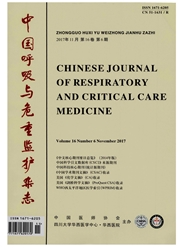

 中文摘要:
中文摘要:
目的探讨建立不同间歇低氧(IH)程度、IH时间和再氧合(ROX)时间以及持续低氧(CH)模式家兔在体颈动脉体和颈总动脉模型。方法由计算机程序控制单片机,在串口通讯协议驱动下,由下位机芯片控制不同氧分压(PO2)灌注液的灌注过程。45只成年雄性新西兰大耳白家兔(2.5~3.0kg)复合麻醉后保留自主呼吸,游离右侧颈总动脉和窦神经(CSN),显露CSN化学感受性神经细束并安放电极记录CSN传入活性。结扎右侧颈总动脉向心端血流,并向右侧颈总动脉远心端内插入导管,经蠕动输液泵交替灌注以发泡法预平衡的灌注液(2mL/min)。灌注低氧灌注液,而后再灌注正常氧灌注液,交替往复形成IH/ROX循环,从而在颈总动脉内模拟出睡眠呼吸暂停状态的不同IH模式IH/ROX暴露情况;或持续灌注低氧液以模拟CH暴露情况。监测颈动脉体CSN传入活性,完成暴露后游离收集颈动脉体和插管远心端的颈总动脉及其分叉作为标本。结果正常氧灌注时CSN化学传入细束的基线频率为(0.17±0.03)次脉冲/s(impulse/s),平均波幅为(46.2±4.4)μV;低氧灌注时传入频率为(0.64±0.09)impulse/s,平均波幅为(87.4±6.6)μV;正常氧灌注液的PO2约为(139±1.5)mmHg,而IH灌注液的PO2约为(35,2±1.3)mmHg。结论该模型可以用于研究不同IH和CH模式时颈动脉体和颈总动脉多种神经和生物化学变化,具有较大的应用价值。
 英文摘要:
英文摘要:
Objective To develope a novel rabbit carotid body and carotid common artery model in vivo for the simulation of various intermittent hypoxia ( IH ) intensities, IH durations, IH reoxygenation (ROX) durations and continuous hypoxia (CH) modes. Methods Forty-five adult New Zealand rabbits (2.5-3.0 kg) were anesthetized while spontaneous breathing kept intact. The tissue surrounding the right carotid common artery and carotid sinus nerve (CSN) were cleared and " single" chemoreceptor bundle of the CSN was revealed. Then suction electrodes were placed and CSN afferent activity was monitored and recorded carefully. The right common carotid artery was exposed, cannulated to distal part and its proximal part was ligated. Preparations were challenged by changing the PO2 of the gas mixture equilibrating the perfusate. Alternatively perfusion (2 mL/min) of equilibrated perfusate bubbled with normoxia or hypoxia gas mixtures formed IH/ROX cycles in carotid common artery, simulating the pattern of hypoxic episodes seen in obstructive sleep apnea syndrome (OSAS) ,or with continuously perfusing hypoxia perfusate to form CH modes. All the perfusing procedures were regulated by a customized computer-controlled set and monitored using O2 gas analyzer. After the systematic exposures, carotid body, carotid common artery part distal to cannula,and carotid bifurcation were harvested as samples. Results The frequencies and average amplitudes of CSN chemoreceptor bundles afferent activities with normoxia perfusion were (0. 17 ± 0.03 ) impulse/s and ( 46. 2 ± 4.4 ) μV, and with hypoxia perfusion were ( 0. 64 ± 0. 09 ) impulse/s and (87.4±6.6) μV, respectively. PO2 was (139 ± 1.5)mm Hg in normoxia perfusate and (35.2 ± 1.3 ) mm Hg in hypoxia perfusate. Conclusion This new carotid body and carotid common artery model is a valuable tool to study neurological and biochemical changes in various IH and CH modes.
 同期刊论文项目
同期刊论文项目
 同项目期刊论文
同项目期刊论文
 Relationship of daytime blood pressure and severity of obstructive sleep apnea among Chinese: a mult
Relationship of daytime blood pressure and severity of obstructive sleep apnea among Chinese: a mult 期刊信息
期刊信息
